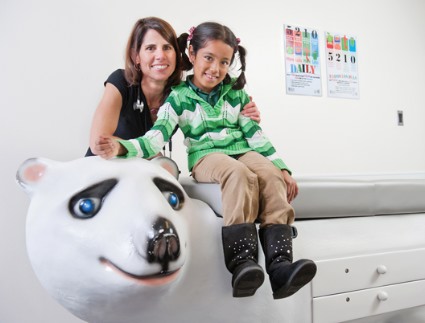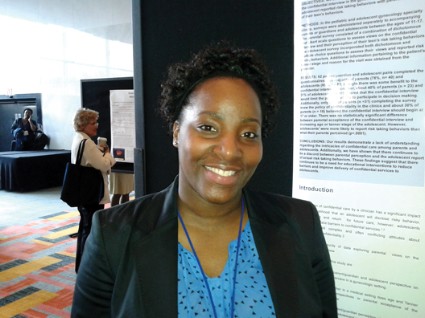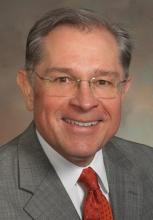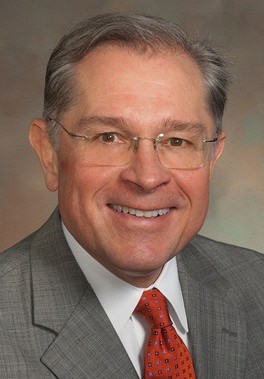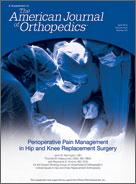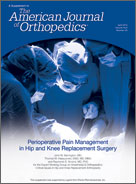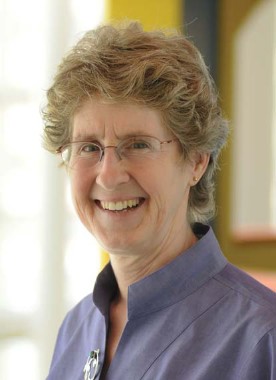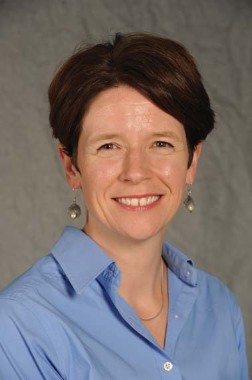User login
Patients in rural areas embracing telepsychiatry
NEW YORK – Remote psychiatric evaluations and consultations appear to be a good call for patients in rural or underserved areas, a telepsychiatrist says.
In a 32-month study, no significant differences were found in the number of adult and child/adolescent evaluations and follow-ups between face-to-face and telepsychiatric services, and both patients and psychiatrists appeared to be happy with the remote interviews, said Dr. Yilmaz Yildirim of the department of psychiatric medicine at East Carolina University in Greenville, N. C.
"The young population loved it," he said in a face-to-face interview.
Elderly patients, particularly women, were hesitant at first, but became "very comfortable" with telepsychiatry over time, he said at the annual meeting of the American Psychiatric Association.
Dr. Yildirim said he was so happy with the results himself that he closed his face-to-face clinic and now conducts all new evaluations and follow-up visits via remote telecommunications.
From August 2010 through March 2013, he provided mental health services in a community health clinic in New Bern, N.C., or via telepsychiatry services to rural counties in eastern North Carolina. The psychiatrist alternated face-to-face and telepsychiatry days.
Over the study period, there were 107 face-to-face clinic days with a total of 1,077 patients and 93 telepsychiatry clinic days seeing 890 patients.
Dr. Yildirim found that the mean number of patients seen per day was 9.79 for the remote visits, compared with 10.40 for face-to-face encounters, a difference that was not significant.
The mean number of new evaluations of adult patients per day was 1.06 for remote visits vs. 0.97 for face-to-face visits (no significant difference), and the mean number of daily adult follow-up visits also was similar at 3.52 and 3.64.
New evaluations of children per day averaged 0.78 for telepsychiatry and 0.93 for the face-to-face clinic, and the mean number of children seen for follow-up daily was identical to that of adult follow-up visits at 3.52 and 3.64, respectively.
The findings show that telepsychiatry is feasible as a means of providing mental health services to adults, children, and adolescents in areas where psychiatrists are few and far between. Telepsychiatry also could be used to provide some forms of therapy, Dr. Yildirim said.
"More telepsychiatry programs should be funded to provide mental health services in rural areas where access to mental health services is difficult," he wrote in a poster presentation.
"I think this would be very good for my country, Brazil, which has a shortage of psychiatrists all over. I think it’s an excellent solution" said Dr. Carlos Horta, a psychiatrist who practices in São Paulo, Brazil.
Dr. Horta was not involved in the study.
The research was supported by East Carolina University. Dr. Yildirim and Dr. Horta reported having no conflicts of interest.
NEW YORK – Remote psychiatric evaluations and consultations appear to be a good call for patients in rural or underserved areas, a telepsychiatrist says.
In a 32-month study, no significant differences were found in the number of adult and child/adolescent evaluations and follow-ups between face-to-face and telepsychiatric services, and both patients and psychiatrists appeared to be happy with the remote interviews, said Dr. Yilmaz Yildirim of the department of psychiatric medicine at East Carolina University in Greenville, N. C.
"The young population loved it," he said in a face-to-face interview.
Elderly patients, particularly women, were hesitant at first, but became "very comfortable" with telepsychiatry over time, he said at the annual meeting of the American Psychiatric Association.
Dr. Yildirim said he was so happy with the results himself that he closed his face-to-face clinic and now conducts all new evaluations and follow-up visits via remote telecommunications.
From August 2010 through March 2013, he provided mental health services in a community health clinic in New Bern, N.C., or via telepsychiatry services to rural counties in eastern North Carolina. The psychiatrist alternated face-to-face and telepsychiatry days.
Over the study period, there were 107 face-to-face clinic days with a total of 1,077 patients and 93 telepsychiatry clinic days seeing 890 patients.
Dr. Yildirim found that the mean number of patients seen per day was 9.79 for the remote visits, compared with 10.40 for face-to-face encounters, a difference that was not significant.
The mean number of new evaluations of adult patients per day was 1.06 for remote visits vs. 0.97 for face-to-face visits (no significant difference), and the mean number of daily adult follow-up visits also was similar at 3.52 and 3.64.
New evaluations of children per day averaged 0.78 for telepsychiatry and 0.93 for the face-to-face clinic, and the mean number of children seen for follow-up daily was identical to that of adult follow-up visits at 3.52 and 3.64, respectively.
The findings show that telepsychiatry is feasible as a means of providing mental health services to adults, children, and adolescents in areas where psychiatrists are few and far between. Telepsychiatry also could be used to provide some forms of therapy, Dr. Yildirim said.
"More telepsychiatry programs should be funded to provide mental health services in rural areas where access to mental health services is difficult," he wrote in a poster presentation.
"I think this would be very good for my country, Brazil, which has a shortage of psychiatrists all over. I think it’s an excellent solution" said Dr. Carlos Horta, a psychiatrist who practices in São Paulo, Brazil.
Dr. Horta was not involved in the study.
The research was supported by East Carolina University. Dr. Yildirim and Dr. Horta reported having no conflicts of interest.
NEW YORK – Remote psychiatric evaluations and consultations appear to be a good call for patients in rural or underserved areas, a telepsychiatrist says.
In a 32-month study, no significant differences were found in the number of adult and child/adolescent evaluations and follow-ups between face-to-face and telepsychiatric services, and both patients and psychiatrists appeared to be happy with the remote interviews, said Dr. Yilmaz Yildirim of the department of psychiatric medicine at East Carolina University in Greenville, N. C.
"The young population loved it," he said in a face-to-face interview.
Elderly patients, particularly women, were hesitant at first, but became "very comfortable" with telepsychiatry over time, he said at the annual meeting of the American Psychiatric Association.
Dr. Yildirim said he was so happy with the results himself that he closed his face-to-face clinic and now conducts all new evaluations and follow-up visits via remote telecommunications.
From August 2010 through March 2013, he provided mental health services in a community health clinic in New Bern, N.C., or via telepsychiatry services to rural counties in eastern North Carolina. The psychiatrist alternated face-to-face and telepsychiatry days.
Over the study period, there were 107 face-to-face clinic days with a total of 1,077 patients and 93 telepsychiatry clinic days seeing 890 patients.
Dr. Yildirim found that the mean number of patients seen per day was 9.79 for the remote visits, compared with 10.40 for face-to-face encounters, a difference that was not significant.
The mean number of new evaluations of adult patients per day was 1.06 for remote visits vs. 0.97 for face-to-face visits (no significant difference), and the mean number of daily adult follow-up visits also was similar at 3.52 and 3.64.
New evaluations of children per day averaged 0.78 for telepsychiatry and 0.93 for the face-to-face clinic, and the mean number of children seen for follow-up daily was identical to that of adult follow-up visits at 3.52 and 3.64, respectively.
The findings show that telepsychiatry is feasible as a means of providing mental health services to adults, children, and adolescents in areas where psychiatrists are few and far between. Telepsychiatry also could be used to provide some forms of therapy, Dr. Yildirim said.
"More telepsychiatry programs should be funded to provide mental health services in rural areas where access to mental health services is difficult," he wrote in a poster presentation.
"I think this would be very good for my country, Brazil, which has a shortage of psychiatrists all over. I think it’s an excellent solution" said Dr. Carlos Horta, a psychiatrist who practices in São Paulo, Brazil.
Dr. Horta was not involved in the study.
The research was supported by East Carolina University. Dr. Yildirim and Dr. Horta reported having no conflicts of interest.
AT THE APA ANNUAL MEETING
Key clinical point: Telepsychiatry appears to be a valuable tool for delivering mental health services to patients living in rural areas.
Major finding: No significant differences were found in the number of new consultations or follow-up mental health visits between a telepsychiatry clinic and traditional in-person clinic. The mean number of new evaluations of adult patients per day was 1.06 for remote visits vs. 0.97 for face-to-face visits, and the mean number of daily adult follow-up visits also was similar at 3.52 and 3.64.
Data source: Retrospective review comparing mean visits for 1,077 adult, child, and adolescent patients seen in face-to-face visits and 890 seen via telemedicine.
Disclosures: The research was supported by East Carolina University. Dr. Yildirim and Dr. Horta reported having no conflicts of interest.
Physicians face hurdles in following new task force fluoride recommendations
Pediatricians may face challenges in implementing new U.S. Preventive Services Task Force recommendations that advocate the provision of oral fluoride supplementation to children in fluoride-deficient areas and fluoride varnish to all children by primary care clinicians.
The speed with which the recommendations are applied in primary care settings likely will depend on state support, training availability, and insurer cooperation.
"The updated recommendations are a very important step forward toward improving oral health in children through collaborative care," Dr. Lee Savio Beers of Children’s National Medical Center, Washington, said in an interview. However, "primary care providers will face a number of barriers in implementing these recommendations, including workflow and staffing issues, access to training, and adequate payment."
The USPSTF guidelines, published in early May 2014, recommend that primary care providers prescribe oral fluoride supplementation starting at 6 months for children whose water supply is lacking in fluoride and that they apply fluoride varnish to the primary teeth of all children starting at primary tooth eruption. The recommendations cite evidence that show fluoride varnish and oral supplements help prevent dental caries in children aged 5 years and younger, and that the treatments’ benefits outweigh the potential harms of fluorosis (Pediatrics 2014[doi:10.15425/peds.2014-0483]). The recommendations update 2004 guidelines in which only oral fluoride supplementation was recommended for children in areas with fluoride levels below 0.6 ppm in their local drinking water. That recommendation remains.
Whether the treatments will be covered by insurers will depend greatly on the state and the insurer. In nearly every state, Medicaid currently reimburses providers for the provision of fluoride varnish, said Dr. Patricia Braun, a pediatrician at Denver Health’s Eastside Neighborhood Health Center, and at the University of Colorado. She is a member of the American Academy of Pediatrics Section on Oral Health.
"From the publically insured perspective, it has already been decided that (such treatments) are important," Dr. Braun said in an interview. "The next challenge will be to get private insurers to do the same. As the task force recommendations indicate, all kids are at risk for caries, some more than others ... and all benefit from these services, including those (who) are insured by private organizations."
Payment for the recommended treatments is an issue that state agencies, professional organizations, and oral health advocates should start investigating now, Dr. Beers added.
"It will be important for pediatric primary care providers, pediatric dentists, regulatory agencies, and payers to work together in each state or region to develop an implementation plan in order to ensure the best intake," she said. "This is not something primary care providers should be expected to implement without this type of comprehensive support, including, but not limited to training and payment."
Training for pediatricians is already available in many states. Most jurisdictions have oral education programs that have been running for some time, Dr. Braun said, such as Colorado’s Cavity Free at Three and North Carolina’s Into the Mouths of Babes. Physicians also can utilize online programs such as Smiles for Life, a national oral health curriculum developed by the Society of Teachers of Family Medicine.
Dr. Beers recommends doctors visit the American Academy of Pediatrics’ website for more information about oral health training programs and resources, the Protecting All Children’s Teeth curriculum and the Bright Futures resources.
"We don’t need to reinvent the wheel," Dr. Braun said. "A lot has really been developed in the last decade, and we can now take advantage of the education" available about these services.
Other challenges physicians may face in executing the recommendations include integrating the treatments into their routine practice, said Dr. Anupama Rao Tate, DMD, of Children’s National Medical Center, dentistry (oral health) department in Washington. For instance, physicians must decide whether the treatments should be provided as part of a well visit or independently.
In addition, electronic records may or may not have a place to track the services, Dr. Tate said. Conversations with parents also are necessary to help families understand why these services are being provided by their children’s primary care provider.
"Traditionally, dentistry has been separate from medicine," Dr. Tate said. Pediatricians are "going to have to change the mindset of parents and educate (them) as to why they’re doing something (pertaining to) dental health."
Pediatricians may face challenges in implementing new U.S. Preventive Services Task Force recommendations that advocate the provision of oral fluoride supplementation to children in fluoride-deficient areas and fluoride varnish to all children by primary care clinicians.
The speed with which the recommendations are applied in primary care settings likely will depend on state support, training availability, and insurer cooperation.
"The updated recommendations are a very important step forward toward improving oral health in children through collaborative care," Dr. Lee Savio Beers of Children’s National Medical Center, Washington, said in an interview. However, "primary care providers will face a number of barriers in implementing these recommendations, including workflow and staffing issues, access to training, and adequate payment."
The USPSTF guidelines, published in early May 2014, recommend that primary care providers prescribe oral fluoride supplementation starting at 6 months for children whose water supply is lacking in fluoride and that they apply fluoride varnish to the primary teeth of all children starting at primary tooth eruption. The recommendations cite evidence that show fluoride varnish and oral supplements help prevent dental caries in children aged 5 years and younger, and that the treatments’ benefits outweigh the potential harms of fluorosis (Pediatrics 2014[doi:10.15425/peds.2014-0483]). The recommendations update 2004 guidelines in which only oral fluoride supplementation was recommended for children in areas with fluoride levels below 0.6 ppm in their local drinking water. That recommendation remains.
Whether the treatments will be covered by insurers will depend greatly on the state and the insurer. In nearly every state, Medicaid currently reimburses providers for the provision of fluoride varnish, said Dr. Patricia Braun, a pediatrician at Denver Health’s Eastside Neighborhood Health Center, and at the University of Colorado. She is a member of the American Academy of Pediatrics Section on Oral Health.
"From the publically insured perspective, it has already been decided that (such treatments) are important," Dr. Braun said in an interview. "The next challenge will be to get private insurers to do the same. As the task force recommendations indicate, all kids are at risk for caries, some more than others ... and all benefit from these services, including those (who) are insured by private organizations."
Payment for the recommended treatments is an issue that state agencies, professional organizations, and oral health advocates should start investigating now, Dr. Beers added.
"It will be important for pediatric primary care providers, pediatric dentists, regulatory agencies, and payers to work together in each state or region to develop an implementation plan in order to ensure the best intake," she said. "This is not something primary care providers should be expected to implement without this type of comprehensive support, including, but not limited to training and payment."
Training for pediatricians is already available in many states. Most jurisdictions have oral education programs that have been running for some time, Dr. Braun said, such as Colorado’s Cavity Free at Three and North Carolina’s Into the Mouths of Babes. Physicians also can utilize online programs such as Smiles for Life, a national oral health curriculum developed by the Society of Teachers of Family Medicine.
Dr. Beers recommends doctors visit the American Academy of Pediatrics’ website for more information about oral health training programs and resources, the Protecting All Children’s Teeth curriculum and the Bright Futures resources.
"We don’t need to reinvent the wheel," Dr. Braun said. "A lot has really been developed in the last decade, and we can now take advantage of the education" available about these services.
Other challenges physicians may face in executing the recommendations include integrating the treatments into their routine practice, said Dr. Anupama Rao Tate, DMD, of Children’s National Medical Center, dentistry (oral health) department in Washington. For instance, physicians must decide whether the treatments should be provided as part of a well visit or independently.
In addition, electronic records may or may not have a place to track the services, Dr. Tate said. Conversations with parents also are necessary to help families understand why these services are being provided by their children’s primary care provider.
"Traditionally, dentistry has been separate from medicine," Dr. Tate said. Pediatricians are "going to have to change the mindset of parents and educate (them) as to why they’re doing something (pertaining to) dental health."
Pediatricians may face challenges in implementing new U.S. Preventive Services Task Force recommendations that advocate the provision of oral fluoride supplementation to children in fluoride-deficient areas and fluoride varnish to all children by primary care clinicians.
The speed with which the recommendations are applied in primary care settings likely will depend on state support, training availability, and insurer cooperation.
"The updated recommendations are a very important step forward toward improving oral health in children through collaborative care," Dr. Lee Savio Beers of Children’s National Medical Center, Washington, said in an interview. However, "primary care providers will face a number of barriers in implementing these recommendations, including workflow and staffing issues, access to training, and adequate payment."
The USPSTF guidelines, published in early May 2014, recommend that primary care providers prescribe oral fluoride supplementation starting at 6 months for children whose water supply is lacking in fluoride and that they apply fluoride varnish to the primary teeth of all children starting at primary tooth eruption. The recommendations cite evidence that show fluoride varnish and oral supplements help prevent dental caries in children aged 5 years and younger, and that the treatments’ benefits outweigh the potential harms of fluorosis (Pediatrics 2014[doi:10.15425/peds.2014-0483]). The recommendations update 2004 guidelines in which only oral fluoride supplementation was recommended for children in areas with fluoride levels below 0.6 ppm in their local drinking water. That recommendation remains.
Whether the treatments will be covered by insurers will depend greatly on the state and the insurer. In nearly every state, Medicaid currently reimburses providers for the provision of fluoride varnish, said Dr. Patricia Braun, a pediatrician at Denver Health’s Eastside Neighborhood Health Center, and at the University of Colorado. She is a member of the American Academy of Pediatrics Section on Oral Health.
"From the publically insured perspective, it has already been decided that (such treatments) are important," Dr. Braun said in an interview. "The next challenge will be to get private insurers to do the same. As the task force recommendations indicate, all kids are at risk for caries, some more than others ... and all benefit from these services, including those (who) are insured by private organizations."
Payment for the recommended treatments is an issue that state agencies, professional organizations, and oral health advocates should start investigating now, Dr. Beers added.
"It will be important for pediatric primary care providers, pediatric dentists, regulatory agencies, and payers to work together in each state or region to develop an implementation plan in order to ensure the best intake," she said. "This is not something primary care providers should be expected to implement without this type of comprehensive support, including, but not limited to training and payment."
Training for pediatricians is already available in many states. Most jurisdictions have oral education programs that have been running for some time, Dr. Braun said, such as Colorado’s Cavity Free at Three and North Carolina’s Into the Mouths of Babes. Physicians also can utilize online programs such as Smiles for Life, a national oral health curriculum developed by the Society of Teachers of Family Medicine.
Dr. Beers recommends doctors visit the American Academy of Pediatrics’ website for more information about oral health training programs and resources, the Protecting All Children’s Teeth curriculum and the Bright Futures resources.
"We don’t need to reinvent the wheel," Dr. Braun said. "A lot has really been developed in the last decade, and we can now take advantage of the education" available about these services.
Other challenges physicians may face in executing the recommendations include integrating the treatments into their routine practice, said Dr. Anupama Rao Tate, DMD, of Children’s National Medical Center, dentistry (oral health) department in Washington. For instance, physicians must decide whether the treatments should be provided as part of a well visit or independently.
In addition, electronic records may or may not have a place to track the services, Dr. Tate said. Conversations with parents also are necessary to help families understand why these services are being provided by their children’s primary care provider.
"Traditionally, dentistry has been separate from medicine," Dr. Tate said. Pediatricians are "going to have to change the mindset of parents and educate (them) as to why they’re doing something (pertaining to) dental health."
AUDIO: Half of families don’t know daughters’ rights in confidential gyn. interview
PHILADELPHIA – Even when parents believe that allowing their adolescent daughter to have a confidential gynecologic interview is to her benefit, they misunderstand the purpose and value of the interview at least half the time.
That’s according to Dr. Gylynthia Trotman, a second-year fellow at Medstar Washington Hospital Center, Children’s National Medical Center, Washington, who presented survey data on the topic during a poster session at the annual meeting of the North American Society for Pediatric and Adolescent Gynecology.
Dr. Trotman and her colleagues found that half of the 62 pairs of parents of adolescent girls aged 11-17 years who’d been seen in a gynecologic specialty clinic feared that if their child were to discuss her health concerns alone with the physician, then the parents would be excluded from the decision-making process.
"The majority of parents felt that this was inappropriate for their teen, because this was a specialized setting," Dr. Trotman said.
In this audio interview, Dr. Trotman explains what families misperceive about the confidential interview and why.
On Twitter @whitneymcknight
PHILADELPHIA – Even when parents believe that allowing their adolescent daughter to have a confidential gynecologic interview is to her benefit, they misunderstand the purpose and value of the interview at least half the time.
That’s according to Dr. Gylynthia Trotman, a second-year fellow at Medstar Washington Hospital Center, Children’s National Medical Center, Washington, who presented survey data on the topic during a poster session at the annual meeting of the North American Society for Pediatric and Adolescent Gynecology.
Dr. Trotman and her colleagues found that half of the 62 pairs of parents of adolescent girls aged 11-17 years who’d been seen in a gynecologic specialty clinic feared that if their child were to discuss her health concerns alone with the physician, then the parents would be excluded from the decision-making process.
"The majority of parents felt that this was inappropriate for their teen, because this was a specialized setting," Dr. Trotman said.
In this audio interview, Dr. Trotman explains what families misperceive about the confidential interview and why.
On Twitter @whitneymcknight
PHILADELPHIA – Even when parents believe that allowing their adolescent daughter to have a confidential gynecologic interview is to her benefit, they misunderstand the purpose and value of the interview at least half the time.
That’s according to Dr. Gylynthia Trotman, a second-year fellow at Medstar Washington Hospital Center, Children’s National Medical Center, Washington, who presented survey data on the topic during a poster session at the annual meeting of the North American Society for Pediatric and Adolescent Gynecology.
Dr. Trotman and her colleagues found that half of the 62 pairs of parents of adolescent girls aged 11-17 years who’d been seen in a gynecologic specialty clinic feared that if their child were to discuss her health concerns alone with the physician, then the parents would be excluded from the decision-making process.
"The majority of parents felt that this was inappropriate for their teen, because this was a specialized setting," Dr. Trotman said.
In this audio interview, Dr. Trotman explains what families misperceive about the confidential interview and why.
On Twitter @whitneymcknight
AT THE NASPAG ANNUAL MEETING
Physicians could get squeezed by Open Payments delay
Website delays may curtail physicians’ ability to review data on payments they received from drug and device makers before the federal government publishes it Sept. 30.
"There is a compelling need to ensure that physicians have an adequate amount of time to register with the Open Payments Program system, to review their consolidated reports, to dispute errors, and obtain corrections," Dr. James L. Madara, AMA executive vice president, wrote in a letter to the Centers for Medicare & Medicaid Services.
CMS got a late start in launching its online system for data collection, created as part of the Affordable Care Act.
The Open Payments Program – colloquially known as the Sunshine Act program – requires manufacturers of drugs, devices, biologicals, and medical supplies to report the honoraria, fees, and other payments that they make to doctors. The information will be published in a searchable database.
Manufacturers began tabulating data in August 2013 and were supposed to start reporting to the CMS through a website on Jan. 1. The program called for doctors to be able to register for the website at the same time so they could begin reviewing data.
CMS launched the website 6 weeks late on Feb. 18 and made it available only to manufacturers and group purchasing organizations. The first registration and reporting phase ended March 31. The agency has not begun the second phase yet.
Registration and review for physicians and teaching hospitals will begin no later than Aug. 1, according to CMS.
The AMA is urging the CMS "to adjust the public reporting date until the agency can ensure that physician due process rights are protected, and the agency has in place a process and system that will produce accurate reports."
The AMA said that it is concerned that the agency might not be able to ensure timeliness or accuracy because "the CMS is building a new system that reportedly has not been beta tested."
The ACA requires the CMS to give physicians 60 days to review data and settle any disputes, according to Neil Kirschner, senior associate for health policy and regulatory affairs at the American College of Physicians. He said that the ACP will continue to monitor the CMS’s progress and advocate for a minimum of a 60-day review period.
Officials at the American College of Cardiology also are wary of the situation.
"Given the difficulties that physicians have had in obtaining access to their Physician Quality Reporting System reports and other similar documents that require authentication of identity, the College is concerned that there will not be sufficient time to both communicate to them the need to register and for the registration and authentication to occur before the reports are available," said Lisa Goldstein, ACC associate director of regulatory affairs.
"Instead, many will likely be scrambling to register and authenticate their identities during the limited review period before the information is made public, reducing the amount of time the physicians have to review their reports and file disputes as appropriate," she said.
Dr. Brett Coldiron, president of the American Academy of Dermatology, said that the academy "wants to ensure that the information that is shared through Open Payments is as accurate as possible, and that implementation of the program is seamless and does not create undue administrative burdens on physicians."
On Twitter @aliciaault
Website delays may curtail physicians’ ability to review data on payments they received from drug and device makers before the federal government publishes it Sept. 30.
"There is a compelling need to ensure that physicians have an adequate amount of time to register with the Open Payments Program system, to review their consolidated reports, to dispute errors, and obtain corrections," Dr. James L. Madara, AMA executive vice president, wrote in a letter to the Centers for Medicare & Medicaid Services.
CMS got a late start in launching its online system for data collection, created as part of the Affordable Care Act.
The Open Payments Program – colloquially known as the Sunshine Act program – requires manufacturers of drugs, devices, biologicals, and medical supplies to report the honoraria, fees, and other payments that they make to doctors. The information will be published in a searchable database.
Manufacturers began tabulating data in August 2013 and were supposed to start reporting to the CMS through a website on Jan. 1. The program called for doctors to be able to register for the website at the same time so they could begin reviewing data.
CMS launched the website 6 weeks late on Feb. 18 and made it available only to manufacturers and group purchasing organizations. The first registration and reporting phase ended March 31. The agency has not begun the second phase yet.
Registration and review for physicians and teaching hospitals will begin no later than Aug. 1, according to CMS.
The AMA is urging the CMS "to adjust the public reporting date until the agency can ensure that physician due process rights are protected, and the agency has in place a process and system that will produce accurate reports."
The AMA said that it is concerned that the agency might not be able to ensure timeliness or accuracy because "the CMS is building a new system that reportedly has not been beta tested."
The ACA requires the CMS to give physicians 60 days to review data and settle any disputes, according to Neil Kirschner, senior associate for health policy and regulatory affairs at the American College of Physicians. He said that the ACP will continue to monitor the CMS’s progress and advocate for a minimum of a 60-day review period.
Officials at the American College of Cardiology also are wary of the situation.
"Given the difficulties that physicians have had in obtaining access to their Physician Quality Reporting System reports and other similar documents that require authentication of identity, the College is concerned that there will not be sufficient time to both communicate to them the need to register and for the registration and authentication to occur before the reports are available," said Lisa Goldstein, ACC associate director of regulatory affairs.
"Instead, many will likely be scrambling to register and authenticate their identities during the limited review period before the information is made public, reducing the amount of time the physicians have to review their reports and file disputes as appropriate," she said.
Dr. Brett Coldiron, president of the American Academy of Dermatology, said that the academy "wants to ensure that the information that is shared through Open Payments is as accurate as possible, and that implementation of the program is seamless and does not create undue administrative burdens on physicians."
On Twitter @aliciaault
Website delays may curtail physicians’ ability to review data on payments they received from drug and device makers before the federal government publishes it Sept. 30.
"There is a compelling need to ensure that physicians have an adequate amount of time to register with the Open Payments Program system, to review their consolidated reports, to dispute errors, and obtain corrections," Dr. James L. Madara, AMA executive vice president, wrote in a letter to the Centers for Medicare & Medicaid Services.
CMS got a late start in launching its online system for data collection, created as part of the Affordable Care Act.
The Open Payments Program – colloquially known as the Sunshine Act program – requires manufacturers of drugs, devices, biologicals, and medical supplies to report the honoraria, fees, and other payments that they make to doctors. The information will be published in a searchable database.
Manufacturers began tabulating data in August 2013 and were supposed to start reporting to the CMS through a website on Jan. 1. The program called for doctors to be able to register for the website at the same time so they could begin reviewing data.
CMS launched the website 6 weeks late on Feb. 18 and made it available only to manufacturers and group purchasing organizations. The first registration and reporting phase ended March 31. The agency has not begun the second phase yet.
Registration and review for physicians and teaching hospitals will begin no later than Aug. 1, according to CMS.
The AMA is urging the CMS "to adjust the public reporting date until the agency can ensure that physician due process rights are protected, and the agency has in place a process and system that will produce accurate reports."
The AMA said that it is concerned that the agency might not be able to ensure timeliness or accuracy because "the CMS is building a new system that reportedly has not been beta tested."
The ACA requires the CMS to give physicians 60 days to review data and settle any disputes, according to Neil Kirschner, senior associate for health policy and regulatory affairs at the American College of Physicians. He said that the ACP will continue to monitor the CMS’s progress and advocate for a minimum of a 60-day review period.
Officials at the American College of Cardiology also are wary of the situation.
"Given the difficulties that physicians have had in obtaining access to their Physician Quality Reporting System reports and other similar documents that require authentication of identity, the College is concerned that there will not be sufficient time to both communicate to them the need to register and for the registration and authentication to occur before the reports are available," said Lisa Goldstein, ACC associate director of regulatory affairs.
"Instead, many will likely be scrambling to register and authenticate their identities during the limited review period before the information is made public, reducing the amount of time the physicians have to review their reports and file disputes as appropriate," she said.
Dr. Brett Coldiron, president of the American Academy of Dermatology, said that the academy "wants to ensure that the information that is shared through Open Payments is as accurate as possible, and that implementation of the program is seamless and does not create undue administrative burdens on physicians."
On Twitter @aliciaault
Perioperative Pain Management in Hip and Knee Replacement Surgery
USPSTF: Evidence still ‘insufficient’ to back cognitive impairment screening
Citing an ongoing lack of data about the benefits and harms of screening, the U.S. Preventive Services Task Force has left unchanged the recommendations of its 2003 guidelines on cognitive impairment screening in older adults, according to an update published March 24.
"The USPSTF concludes that the current evidence is insufficient to assess the balance of benefits and harms of screening for cognitive impairment," Dr. Virginia A. Moyer said in a report on behalf of the USPSTF.
"Evidence on the effect of screening and early detection of mild to moderate dementia on decision making, planning, or other important patient outcomes is a critical gap in the evidence," she added. Other research needs include further study of the harms of screening, new interventions that address the changing needs of patients and families, and interventions that affect the long-term clinical direction of mild to moderate dementia.
In its review, the USPSTF evaluated 55 studies on instruments that screen for cognitive impairment, of which 46 provided evidence on the sensitivity of dementia screening and 27 provided evidence on mild cognitive impairment. Screening tests included a variety of tasks to assess at least one cognitive function, such as memory, attention, language, and visuospatial/executive functioning. The USPSTF looked at studies that used the Mini-Mental State Examination (MMSE), Clock Drawing Test, verbal fluency tests, Informant Questionnaire on Cognitive Decline in the Elderly, Memory Impairment Screen, Mini-Cog Test, Abbreviated Mental Test, and Short Portable Mental Status Questionnaire.
The MMSE was the most evaluated screening tool, with 25 published studies. Mean age of participants ranged from 69 to 95 years, and the mean prevalence of dementia ranged from 1.2% to 38%. The pooled sensitivity from 14 studies for the most commonly reported cut points was 88.3% (95% confidence interval, 81.3%-92.9%), and specificity was 86.2% (CI, 81.8%-89.7%).
Other screening tools that were evaluated "were studied in far fewer studies (four to seven studies each), had limited reproducibility in primary care relevant populations, and had unknown optimum cut points," Dr. Moyer wrote.
In addition, no trials studied the "direct effect of screening" by comparing screened and unscreened patients and reporting important clinical and decision-making outcomes, the report’s authors said. And no studies reported on direct or indirect harms from false-positive or false-negative screening results, psychological harms, unnecessary diagnostic testing, or labeling.
Dementia affects about 2.4 to 5.5 million Americans. Types of dementia in older adults include Alzheimer’s disease, vascular dementia, frontotemporal dementia, dementia with Lewy bodies, Parkinson’s disease with dementia, and mixed-cause dementia. The USPSTF distinguishes between dementia and mild cognitive impairment, which is less severe and does not considerably interfere with day-to-day activities.
The prevalence of dementia is estimated to be 5% in adults aged 71-79 years of age, 24% in those aged 80-89 years, and 37% in those aged 90 years and older. The prevalence of mild cognitive impairment is more uncertain, and estimates range from 3% to 42% in adults aged 65 years and older.
Although this report differs from the 2003 recommendation because it considers screening and treatment for mild cognitive impairment in addition to dementia, and it includes additional information about the test performance of screening instruments, "the overall evidence is insufficient to make a recommendation on screening," Dr. Moyer said.
Disclosure forms from USPSTF members can be viewed here.
Citing an ongoing lack of data about the benefits and harms of screening, the U.S. Preventive Services Task Force has left unchanged the recommendations of its 2003 guidelines on cognitive impairment screening in older adults, according to an update published March 24.
"The USPSTF concludes that the current evidence is insufficient to assess the balance of benefits and harms of screening for cognitive impairment," Dr. Virginia A. Moyer said in a report on behalf of the USPSTF.
"Evidence on the effect of screening and early detection of mild to moderate dementia on decision making, planning, or other important patient outcomes is a critical gap in the evidence," she added. Other research needs include further study of the harms of screening, new interventions that address the changing needs of patients and families, and interventions that affect the long-term clinical direction of mild to moderate dementia.
In its review, the USPSTF evaluated 55 studies on instruments that screen for cognitive impairment, of which 46 provided evidence on the sensitivity of dementia screening and 27 provided evidence on mild cognitive impairment. Screening tests included a variety of tasks to assess at least one cognitive function, such as memory, attention, language, and visuospatial/executive functioning. The USPSTF looked at studies that used the Mini-Mental State Examination (MMSE), Clock Drawing Test, verbal fluency tests, Informant Questionnaire on Cognitive Decline in the Elderly, Memory Impairment Screen, Mini-Cog Test, Abbreviated Mental Test, and Short Portable Mental Status Questionnaire.
The MMSE was the most evaluated screening tool, with 25 published studies. Mean age of participants ranged from 69 to 95 years, and the mean prevalence of dementia ranged from 1.2% to 38%. The pooled sensitivity from 14 studies for the most commonly reported cut points was 88.3% (95% confidence interval, 81.3%-92.9%), and specificity was 86.2% (CI, 81.8%-89.7%).
Other screening tools that were evaluated "were studied in far fewer studies (four to seven studies each), had limited reproducibility in primary care relevant populations, and had unknown optimum cut points," Dr. Moyer wrote.
In addition, no trials studied the "direct effect of screening" by comparing screened and unscreened patients and reporting important clinical and decision-making outcomes, the report’s authors said. And no studies reported on direct or indirect harms from false-positive or false-negative screening results, psychological harms, unnecessary diagnostic testing, or labeling.
Dementia affects about 2.4 to 5.5 million Americans. Types of dementia in older adults include Alzheimer’s disease, vascular dementia, frontotemporal dementia, dementia with Lewy bodies, Parkinson’s disease with dementia, and mixed-cause dementia. The USPSTF distinguishes between dementia and mild cognitive impairment, which is less severe and does not considerably interfere with day-to-day activities.
The prevalence of dementia is estimated to be 5% in adults aged 71-79 years of age, 24% in those aged 80-89 years, and 37% in those aged 90 years and older. The prevalence of mild cognitive impairment is more uncertain, and estimates range from 3% to 42% in adults aged 65 years and older.
Although this report differs from the 2003 recommendation because it considers screening and treatment for mild cognitive impairment in addition to dementia, and it includes additional information about the test performance of screening instruments, "the overall evidence is insufficient to make a recommendation on screening," Dr. Moyer said.
Disclosure forms from USPSTF members can be viewed here.
Citing an ongoing lack of data about the benefits and harms of screening, the U.S. Preventive Services Task Force has left unchanged the recommendations of its 2003 guidelines on cognitive impairment screening in older adults, according to an update published March 24.
"The USPSTF concludes that the current evidence is insufficient to assess the balance of benefits and harms of screening for cognitive impairment," Dr. Virginia A. Moyer said in a report on behalf of the USPSTF.
"Evidence on the effect of screening and early detection of mild to moderate dementia on decision making, planning, or other important patient outcomes is a critical gap in the evidence," she added. Other research needs include further study of the harms of screening, new interventions that address the changing needs of patients and families, and interventions that affect the long-term clinical direction of mild to moderate dementia.
In its review, the USPSTF evaluated 55 studies on instruments that screen for cognitive impairment, of which 46 provided evidence on the sensitivity of dementia screening and 27 provided evidence on mild cognitive impairment. Screening tests included a variety of tasks to assess at least one cognitive function, such as memory, attention, language, and visuospatial/executive functioning. The USPSTF looked at studies that used the Mini-Mental State Examination (MMSE), Clock Drawing Test, verbal fluency tests, Informant Questionnaire on Cognitive Decline in the Elderly, Memory Impairment Screen, Mini-Cog Test, Abbreviated Mental Test, and Short Portable Mental Status Questionnaire.
The MMSE was the most evaluated screening tool, with 25 published studies. Mean age of participants ranged from 69 to 95 years, and the mean prevalence of dementia ranged from 1.2% to 38%. The pooled sensitivity from 14 studies for the most commonly reported cut points was 88.3% (95% confidence interval, 81.3%-92.9%), and specificity was 86.2% (CI, 81.8%-89.7%).
Other screening tools that were evaluated "were studied in far fewer studies (four to seven studies each), had limited reproducibility in primary care relevant populations, and had unknown optimum cut points," Dr. Moyer wrote.
In addition, no trials studied the "direct effect of screening" by comparing screened and unscreened patients and reporting important clinical and decision-making outcomes, the report’s authors said. And no studies reported on direct or indirect harms from false-positive or false-negative screening results, psychological harms, unnecessary diagnostic testing, or labeling.
Dementia affects about 2.4 to 5.5 million Americans. Types of dementia in older adults include Alzheimer’s disease, vascular dementia, frontotemporal dementia, dementia with Lewy bodies, Parkinson’s disease with dementia, and mixed-cause dementia. The USPSTF distinguishes between dementia and mild cognitive impairment, which is less severe and does not considerably interfere with day-to-day activities.
The prevalence of dementia is estimated to be 5% in adults aged 71-79 years of age, 24% in those aged 80-89 years, and 37% in those aged 90 years and older. The prevalence of mild cognitive impairment is more uncertain, and estimates range from 3% to 42% in adults aged 65 years and older.
Although this report differs from the 2003 recommendation because it considers screening and treatment for mild cognitive impairment in addition to dementia, and it includes additional information about the test performance of screening instruments, "the overall evidence is insufficient to make a recommendation on screening," Dr. Moyer said.
Disclosure forms from USPSTF members can be viewed here.
FROM A USPSTF REPORT
A child’s death
As a general pediatrician, I am fortunate that most of my patients are thriving and healthy. Even those with chronic disease have the access to lifesaving medicines and treatments that offer most of them the opportunity for a long, full life. Perhaps in part because so many of my patients are healthy, and death is not something I must face on a regular basis, each time it happens I feel a bit lost and unprepared.
Very sadly, over the past several months, four of my patients have died – each under very different circumstances. While the sadness and loss I, and others on their medical team, felt each time we learned of an untimely death in no way comes close to what our patient’s families are experiencing, we are still affected. As a medical team, we also share a responsibility to families to extend our support through their grief – which may extend for many, many years, and we often may continue to provide medical care for siblings or other family members, whose grief may go unrecognized or forgotten.
Over the years, I have realized how important it is to recognize and confront my own feelings about a patient’s death in order to be able to support their family. I also have realized that it is equally important to provide an opportunity for the rest of the patient’s care team to grieve and debrief. Often the care team may look to the physician to start or provide the opportunity for this conversation. Many emotions may unearth themselves – from fear to grief to overwhelming sadness. Addressing these emotions in a safe environment helps to ensure that, as providers, we then are able to provide helpful support to families in mourning.
The American Academy of Pediatrics has published a very thoughtful and helpful clinical report, "Supporting the Family After the Death of a Child," which walks the provider through important issues and concerns (Pediatrics 2012;130:1164-9). The most powerful step providers can take, which is identified in this report and I fully agree with, is to call or personally visit the family. Attending the patient’s funeral or memorial service also can be meaningful and important, but a private, personal contact is invaluable to allow the family the opportunity to ask questions or express concerns they may not want to express publicly. This is not a time for us as providers to offer advice or justification, but merely to listen and grieve together.
That said, there are times when it becomes clear – for whatever reason – that a family doesn’t want to or isn’t ready to talk with someone from the medical care team. In those circumstances, I still think the mere act of trying to reach out and express your sadness and condolences is important. There have been times when families reached back out to me weeks or months later with questions or thoughts – an initial attempt at contact helps a family to know that you are available and willing to talk. One mother called me months after her child’s death – she had begun the process of cleaning out her daughter’s room and wasn’t sure how to dispose of her medications. A simple piece of information I was able to give her made an impossibly hard task a little easier, and was another touch point for us to talk about her daughter’s many strengths and how much we all missed her.
The AAP report also highlights some family support resources that are useful to know about and share with families. The loss of a child is indescribable, and many find comfort in sharing their feelings with others who have gone through a similar experience. Some resources highlighted in the report are The Compassionate Friends, a national self-help support organization for parents who have lost a child (www.compassionatefriends.org); SHARE, an organization that serves parents who have lost a child through pregnancy loss, stillbirth, or in the first few months of life (www.nationalshare.org); Bereaved Parents of the USA, providing support to bereaved caregivers and siblings (www.bereavedparentsusa.org) and Survivors of Suicide, for those who have lost a family member or loved one to suicide (www.survivorsofsuicide.com).
Through their own actions and the utilization of community resources, pediatric providers can be an important support for grieving families.
Dr. Beers is an assistant professor of pediatrics at Children’s National Medical Center and the George Washington University Medical Center, Washington. She is chair of the American Academy of Pediatrics Committee on Residency Scholarships and president of the District of Columbia chapter of the American Academy of Pediatrics. E-mail Dr. Beers at [email protected]. To read more commentaries, visit pediatricnews.com/views/practical-parenting.html.
As a general pediatrician, I am fortunate that most of my patients are thriving and healthy. Even those with chronic disease have the access to lifesaving medicines and treatments that offer most of them the opportunity for a long, full life. Perhaps in part because so many of my patients are healthy, and death is not something I must face on a regular basis, each time it happens I feel a bit lost and unprepared.
Very sadly, over the past several months, four of my patients have died – each under very different circumstances. While the sadness and loss I, and others on their medical team, felt each time we learned of an untimely death in no way comes close to what our patient’s families are experiencing, we are still affected. As a medical team, we also share a responsibility to families to extend our support through their grief – which may extend for many, many years, and we often may continue to provide medical care for siblings or other family members, whose grief may go unrecognized or forgotten.
Over the years, I have realized how important it is to recognize and confront my own feelings about a patient’s death in order to be able to support their family. I also have realized that it is equally important to provide an opportunity for the rest of the patient’s care team to grieve and debrief. Often the care team may look to the physician to start or provide the opportunity for this conversation. Many emotions may unearth themselves – from fear to grief to overwhelming sadness. Addressing these emotions in a safe environment helps to ensure that, as providers, we then are able to provide helpful support to families in mourning.
The American Academy of Pediatrics has published a very thoughtful and helpful clinical report, "Supporting the Family After the Death of a Child," which walks the provider through important issues and concerns (Pediatrics 2012;130:1164-9). The most powerful step providers can take, which is identified in this report and I fully agree with, is to call or personally visit the family. Attending the patient’s funeral or memorial service also can be meaningful and important, but a private, personal contact is invaluable to allow the family the opportunity to ask questions or express concerns they may not want to express publicly. This is not a time for us as providers to offer advice or justification, but merely to listen and grieve together.
That said, there are times when it becomes clear – for whatever reason – that a family doesn’t want to or isn’t ready to talk with someone from the medical care team. In those circumstances, I still think the mere act of trying to reach out and express your sadness and condolences is important. There have been times when families reached back out to me weeks or months later with questions or thoughts – an initial attempt at contact helps a family to know that you are available and willing to talk. One mother called me months after her child’s death – she had begun the process of cleaning out her daughter’s room and wasn’t sure how to dispose of her medications. A simple piece of information I was able to give her made an impossibly hard task a little easier, and was another touch point for us to talk about her daughter’s many strengths and how much we all missed her.
The AAP report also highlights some family support resources that are useful to know about and share with families. The loss of a child is indescribable, and many find comfort in sharing their feelings with others who have gone through a similar experience. Some resources highlighted in the report are The Compassionate Friends, a national self-help support organization for parents who have lost a child (www.compassionatefriends.org); SHARE, an organization that serves parents who have lost a child through pregnancy loss, stillbirth, or in the first few months of life (www.nationalshare.org); Bereaved Parents of the USA, providing support to bereaved caregivers and siblings (www.bereavedparentsusa.org) and Survivors of Suicide, for those who have lost a family member or loved one to suicide (www.survivorsofsuicide.com).
Through their own actions and the utilization of community resources, pediatric providers can be an important support for grieving families.
Dr. Beers is an assistant professor of pediatrics at Children’s National Medical Center and the George Washington University Medical Center, Washington. She is chair of the American Academy of Pediatrics Committee on Residency Scholarships and president of the District of Columbia chapter of the American Academy of Pediatrics. E-mail Dr. Beers at [email protected]. To read more commentaries, visit pediatricnews.com/views/practical-parenting.html.
As a general pediatrician, I am fortunate that most of my patients are thriving and healthy. Even those with chronic disease have the access to lifesaving medicines and treatments that offer most of them the opportunity for a long, full life. Perhaps in part because so many of my patients are healthy, and death is not something I must face on a regular basis, each time it happens I feel a bit lost and unprepared.
Very sadly, over the past several months, four of my patients have died – each under very different circumstances. While the sadness and loss I, and others on their medical team, felt each time we learned of an untimely death in no way comes close to what our patient’s families are experiencing, we are still affected. As a medical team, we also share a responsibility to families to extend our support through their grief – which may extend for many, many years, and we often may continue to provide medical care for siblings or other family members, whose grief may go unrecognized or forgotten.
Over the years, I have realized how important it is to recognize and confront my own feelings about a patient’s death in order to be able to support their family. I also have realized that it is equally important to provide an opportunity for the rest of the patient’s care team to grieve and debrief. Often the care team may look to the physician to start or provide the opportunity for this conversation. Many emotions may unearth themselves – from fear to grief to overwhelming sadness. Addressing these emotions in a safe environment helps to ensure that, as providers, we then are able to provide helpful support to families in mourning.
The American Academy of Pediatrics has published a very thoughtful and helpful clinical report, "Supporting the Family After the Death of a Child," which walks the provider through important issues and concerns (Pediatrics 2012;130:1164-9). The most powerful step providers can take, which is identified in this report and I fully agree with, is to call or personally visit the family. Attending the patient’s funeral or memorial service also can be meaningful and important, but a private, personal contact is invaluable to allow the family the opportunity to ask questions or express concerns they may not want to express publicly. This is not a time for us as providers to offer advice or justification, but merely to listen and grieve together.
That said, there are times when it becomes clear – for whatever reason – that a family doesn’t want to or isn’t ready to talk with someone from the medical care team. In those circumstances, I still think the mere act of trying to reach out and express your sadness and condolences is important. There have been times when families reached back out to me weeks or months later with questions or thoughts – an initial attempt at contact helps a family to know that you are available and willing to talk. One mother called me months after her child’s death – she had begun the process of cleaning out her daughter’s room and wasn’t sure how to dispose of her medications. A simple piece of information I was able to give her made an impossibly hard task a little easier, and was another touch point for us to talk about her daughter’s many strengths and how much we all missed her.
The AAP report also highlights some family support resources that are useful to know about and share with families. The loss of a child is indescribable, and many find comfort in sharing their feelings with others who have gone through a similar experience. Some resources highlighted in the report are The Compassionate Friends, a national self-help support organization for parents who have lost a child (www.compassionatefriends.org); SHARE, an organization that serves parents who have lost a child through pregnancy loss, stillbirth, or in the first few months of life (www.nationalshare.org); Bereaved Parents of the USA, providing support to bereaved caregivers and siblings (www.bereavedparentsusa.org) and Survivors of Suicide, for those who have lost a family member or loved one to suicide (www.survivorsofsuicide.com).
Through their own actions and the utilization of community resources, pediatric providers can be an important support for grieving families.
Dr. Beers is an assistant professor of pediatrics at Children’s National Medical Center and the George Washington University Medical Center, Washington. She is chair of the American Academy of Pediatrics Committee on Residency Scholarships and president of the District of Columbia chapter of the American Academy of Pediatrics. E-mail Dr. Beers at [email protected]. To read more commentaries, visit pediatricnews.com/views/practical-parenting.html.



